Planting and moving
Continue to plant bare-root deciduous hedging plants and trees. Put biodegradable rabbit guards around newly planted trees and shrubs to protect the bark from damage.
Plant roses, preferably bare root as these establish better and are more environmentally friendly, but avoid areas where roses were previously grown as this can lead to problems with replant diseases.
Move established deciduous trees and shrubs if necessary, provided the ground is not frozen or soggy. If they are more than a couple of years old, consider leaving them and planting new ones, as it will be hard to remove a large enough rootball for the plant to survive.
Pruning and training
Tie wall shrubs and climbers onto their supports to protect them from wind damage.
Pruning and renovation of many deciduous trees, shrubs and hedges can be carried out from now throughout the dormant season. Examples include beech, hazel and hornbeam. Some are best to leave until spring, including tender plants, evergreens, and Prunus species (e.g. ornamental cherries, plums and almonds) as these are vulnerable to silver leaf if pruned in the autumn or winter.
Hold off on hydrangea pruning until March, as the old flowerheads will help to protect the shoots from frost.
Large trees can be difficult to prune. Take care not to damage the tree by tearing the bark when sawing off thicker branches. It may be best to consult a tree surgeon.
Propagation
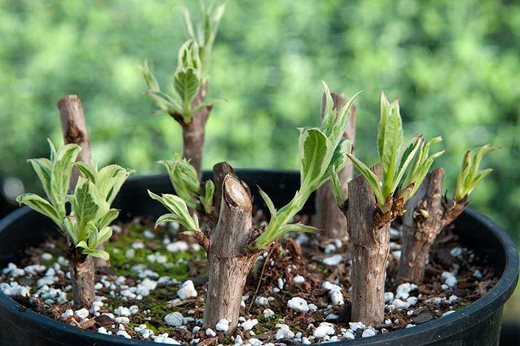 Take hardwood cuttings of ornamental shrubs such as Berberis, buddleia, willow, Forsythia, privet and Rubus. Many deciduous climbers can also be propagated in this way (e.g. honeysuckle and crimson glory vine).
Take hardwood cuttings of ornamental shrubs such as Berberis, buddleia, willow, Forsythia, privet and Rubus. Many deciduous climbers can also be propagated in this way (e.g. honeysuckle and crimson glory vine).
Check hardwood cuttings taken last year. They may need planting out or potting on if well rooted.
Christmas tree care
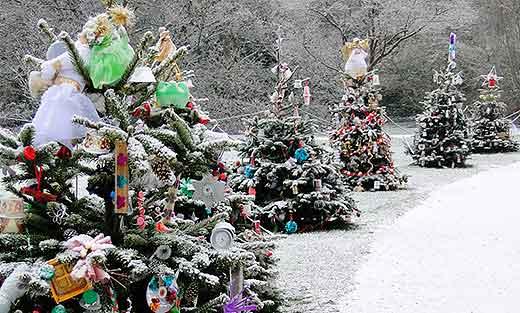 Reduce needle drop on your Christmas tree by choosing a pine (Pinus) or fir (Abies) instead of the traditional Norway spruce (Picea abies). These hold their needles for longer. Avoid placing your tree near sources of heat such as a fire, log burner or radiator. Cut trees will last longer if stood in a bucket of water or a stand with a reservoir. Saw off the bottom 5-8cm (2-3in) of trunk to allow the tree to drink.
Reduce needle drop on your Christmas tree by choosing a pine (Pinus) or fir (Abies) instead of the traditional Norway spruce (Picea abies). These hold their needles for longer. Avoid placing your tree near sources of heat such as a fire, log burner or radiator. Cut trees will last longer if stood in a bucket of water or a stand with a reservoir. Saw off the bottom 5-8cm (2-3in) of trunk to allow the tree to drink.
General maintenance
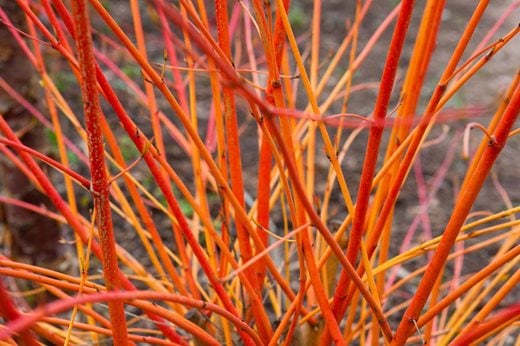 When visiting gardens and garden centres, take note of the most colourful dogwood, willow and white-stemmed Rubus cultivars. Consider planting some for a winter display.
When visiting gardens and garden centres, take note of the most colourful dogwood, willow and white-stemmed Rubus cultivars. Consider planting some for a winter display.
Protect newly planted trees, hedges and shrubs from cold winds and frosts, which can loosen and lift the roots. Gently re-firm them in if you notice this problem, and put up a temporary netting windbreak if there is no natural shelter. Thick dry mulches, such as straw or composted bark, will protect the roots from cold.
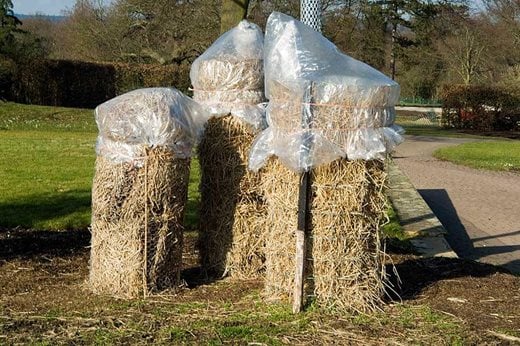 Tender trees and shrubs can be covered with re-used or biodegradable fleece, or packed with dry straw or bracken and then covered with fleece. For tender evergreens, a wooden frame with re-used clear polythene stretched over it does a similar job without blocking the light, but don’t let the polythene touch the leaves, as condensation could freeze or cause rots.
Tender trees and shrubs can be covered with re-used or biodegradable fleece, or packed with dry straw or bracken and then covered with fleece. For tender evergreens, a wooden frame with re-used clear polythene stretched over it does a similar job without blocking the light, but don’t let the polythene touch the leaves, as condensation could freeze or cause rots.
Check tree ties and stakes. Replace, tighten, slacken or remove as necessary. Remove weeds from around the bases of young trees by hand.
When there is snow in your area, then you may need to brush it off the branches of conifers, climbers and light-limbed shrubs and trees. Heavy snowfall can splay branches, break limbs and spoil the shape of the tree.
You may wish to protect a few holly berries from the birds, for use in Christmas decorations. Netting should do the job, but do leave some uncovered for winter wildlife.
Problems
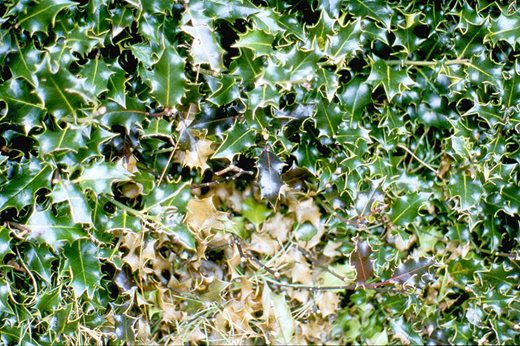 Look out for holly leaf blight, which is rare, but can be spread in wet weather. Cut out affected areas and add to your council green waste collection.
Look out for holly leaf blight, which is rare, but can be spread in wet weather. Cut out affected areas and add to your council green waste collection.
Phytophthora root rots can cause dieback on mature trees and shrubs. Wet winter weather and poorly drained soils are likely to encourage this problem on susceptible woody plants.
Garden hygiene helps to reduce disease reoccurence next year. Rake up any infected leaves and add to your council compost collection. Diseases such as black spot on roses, scab on apples and pears and quince leaf blight can all be reduced in this way.
Place biodegradable tree guards around any newly planted trees and shrubs to protect from deer, rabbit and squirrel damage.
Damage from bay suckers may still be evident, although the insects will have been and gone. Remove affected leaves if there are only a few, and look out for damage next spring, usually around May, to remove affected leaves promptly. Add these to your council green waste collection.
Coral spot disease is often noticed once the leaves have fallen from deciduous hedges, shrubs and trees. This is caused by poor ventilation from congestion, so cut out affected branches and prune to improve airflow.

